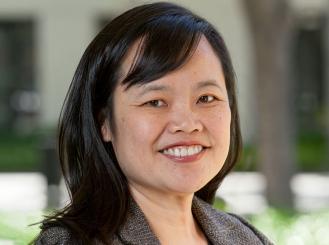Mar 01, 2016
A study in the Journal of Global Oncology (JGO) set out to identify factors associated with survival among Chinese Americans diagnosed with lung cancer. The study, “Lung Cancer Survival Among Chinese Americans, 2000 to 2010,” published online, ahead of print, January 20, found that men and women differed in terms of factors associated with greater survival. Among both men and women, longer survival was associated with receiving care at a National Cancer Institute (NCI) cancer center and the patient’s cancer histology type. However, among women, living longer was also associated with social factors: The study found that married women lived longer than unmarried women and that those in neighborhoods with a higher socioeconomic status (SES) lived longer than those in neighborhoods of lower SES. In addition, the study found that Chinese American women diagnosed with lung cancer lived on average 5.7 months longer than Chinese American men with the same diagnosis (13 versus 18.7 months).
According to the study’s first author, Scarlett Lin Gomez, PhD, MPH, an epidemiologist at the Cancer Prevention Institute of California and a member of the Stanford Cancer Institute, no previous studies have analyzed patterns of survival among Chinese Americans diagnosed with lung cancer. Filling this research gap is important since among the 4 million Chinese Americans in the United States, lung cancer is the second most common cancer among men and the fourth most common cancer among women. For both Chinese American men and women, lung cancer is the most common cause of cancer deaths.
Laying the groundwork for interventions to prolong survival
According to Dr. Gomez, identifying the factors associated with shorter survival after a lung cancer diagnosis allows researchers to begin developing interventions targeted to those at risk.
"The benefit of this kind of epidemiology is that we can uncover patterns that help us pinpoint areas where we might focus, whether for targeted research or interventions. In this study specifically, we saw that marital status had an effect on survival among women. The question is: Is this effect seen because women who are married have greater social support, mental support, or financial support?” said Dr. Gomez. “We also found that higher neighborhood SES is associated with survival. Is the driving factor here that some neighborhoods have greater access to certain economic and medical resources? Once we are able to determine which factors are are driving these patterns, we can design targeted interventions to help improve the length and quality of survival, and not only for Chinese Americans.”
Unique patterns of lung cancer among Chinese Americans
Dr. Gomez explained that she chose to focus her research on Chinese Americans diagnosed with lung cancer because of the population’s unique characteristics.
"One, among Chinese Americans, rates of lung cancer have been either increasing or stable, depending on which histology you look at. And this is interesting because this is in contrast to patterns we see in other U.S. populations, where rates are declining,” said Dr. Gomez. "Second, lung cancer is the most common cause of death in the Chinese American population. Third, Chinese Americans tend to have unique molecular profiles such as EGFR mutations, and among Chinese American females, there is a much, much higher proportion of those who have never smoked."
Where patients received care, histology, and social factors affect survival
To carry out the analysis, the researchers looked to the population-based California Cancer Registry for data on 1,616 women and 2,216 men who were diagnosed with lung cancer between 2000 and 2010. The researchers analyzed the data to find associations between survival time and eight clinical and social factors, including place of birth (whether the United States or China), marital status, health insurance type, neighborhood SES, the degree to which a patient’s neighborhood is an ethnic enclave (defined as having more Asian ethnic norms and/or is ethnically distinct from the surrounding area), cancer histology, cancer stage, and care at an NCI-designated cancer center (NCI centers were used as a proxy for academic health centers).
The study found that men who were treated at NCI-designated centers lived an average of 22.4 months, whereas those treated at non-NCI centers lived for an average of 12.1 months. The study also found that among men with non-small cell lung carcinoma, those with adenocarcinoma lived an average of 19.2 months, while those with large cell lived an average of 11.8 months.
Chinese American women treated at NCI centers also lived significantly longer than Chinese American women not treated at NCI centers (34.2 months versus 17.6 months). In addition, women with squamous cell histology lived longer than women with small-cell histology (12.0 versus 10.6). In terms of the social factors significantly associated with longevity after diagnosis, married women lived 3.1 months longer than non-married women (21.8 versus 18.7 months). In addition, women who lived in neighborhoods that fell within the highest quintile of SES lived a full 12.3 months longer than women who lived in lower-income neighborhoods.
Scarlett Lin Gomez, PhD, MPH, is a Research Scientists at the Cancer Prevention Institute of California, in Fremont, CA. She is also a Consulting Associate Professor in the Division of Epidemiology, Department of Health Research and Policy, at Stanford University School of Medicine, and a member of the Stanford Cancer Institute. She has been an ASCO member since 2010 and is a member of the Health Disparities Committee.
Abstract of the original JGO article.
PDF of the original JGO article.
Gomez SL, Yang J, Lin SW, et al. Lung cancer survival among Chinese Americans, 2000-2010. J Glob Oncol. Epub 2016 Jan 20.
The Exclusive Coverage series on ASCOconnection.org highlights selected research from JCO, JGO, and JOP, with additional perspective provided by the lead or corresponding author.
@ 2016 American Society of Clinical Oncology


